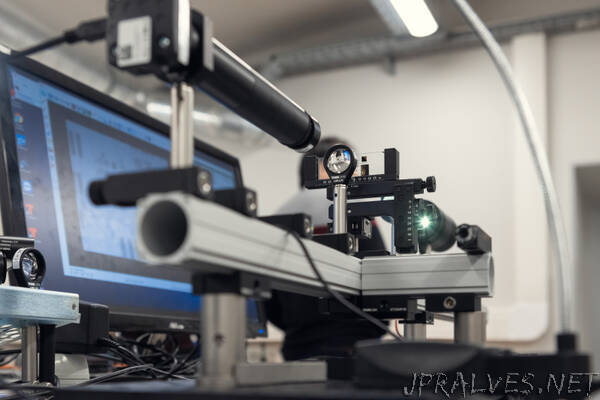
“Researchers from ITMO have demonstrated a novel technique for generation of laser radiation that utilizes perovskite metasurfaces. The solution will pave the way for next-gen lasers that are less than 100 nm thick and require significantly less energy. The invention can be incorporated into compact photonic chips for light control or used as an intense light source in medicine (e.g., for tissue or blood diagnostics), materials processing, astronomy, and other fields. The results of this study were published in the journal Advanced Functional Materials.
The global photonics community is directing its efforts towards developing advanced lasers that are both low-threshold and cost-efficient. As most lasers consist of a pump source, an active medium, and a resonator, specialists have to pump the active medium with energy to establish a population inversion – a state in which the number of excited electrons and holes (positively charged particles) is greater than of those in a normal, unexcited state. When members of the system are excited – or, in other words, are separated from an atom, which happens, for instance, during energy transfer – they can freely move within a semiconductor. As an electron returns to its ground state, it releases energy in the form of a photon or, in other words, a particle of light. Although it is widely used to generate laser radiation via resonators, the process, however, comes with a huge drawback – it requires large amounts of energy.
To lower the energy demands for lasers, scientists are trying to bypass the need for a population inversion by making use of highly-promising exciton-polaritons. These quasiparticles are, in fact, hybrids of light and matter that produce ultrafast nonlinear optical effects. Additionally, their effective mass is several orders of magnitude smaller than that of, for instance, electrons, which leads to the creation of a Bose-Einstein condensate.
This state of matter, which manifests itself in low-threshold laser emission, is of interest for researchers because it requires no population inversion and reduces energy demands. Apart from that, the state facilitates a variety of phenomena, such as the Bogoliubov transformation, which is yet to be experimentally observed.
Recently, researchers recently managed to reproduce the state in a polariton lattice based on a GaAs quantum well. That said, the developed material exhibits low exciton binding energies, which limits its operating temperature, at which the exciton – and hence exciton-polariton – can generate laser emission, to -267°C.
What ITMO researchers suggest
Scientists from ITMO University came up with a novel approach to generating polariton laser radiation, which will allow for the use of polariton systems in commercial products. Their method is based on a perovskite metasurface upon which the so-called exceptional points appear under the influence of optical pumping in the nonlinear regime. The effect creates favorable conditions for polariton condensation, which is necessary for lasers.
The major advantage of the method is that the system offered is made up of low-costing perovskites and does not call for expensive synthesis procedures. While polariton condensation is typically observed in vertical Bragg resonators based on high-precision multilayer systems, the scientists managed to achieve the same effect on only one lattice thanks to perovskites. The lattice is compact and affordable and its fabrication method, nanoimprint lithography, can be easily scaled up. Moreover, condensed polaritons in such a lattice have powerful nonlinear optical properties, which makes it possible to control laser radiation and its spectrum using light.
The course of the study
The researchers synthesized a thin perovskite film which was then turned into a lattice-like metasurface via nanoimprint lithography. A Blu-ray disc acted as a mold for the fabrication process. The resulting metasurface is just 75 nm thick, which is the smallest possible thickness achieved in such a process.
The sample was then studied via angular resolution spectroscopy, which means that the researchers subjected the microsurface to optical pumping in the nonlinear regime and measured the wavelength and angle of the resulting lasing emission. The sample under study was compared to another one that was 10 nanometers thinner. This difference proved to be critical when trying to provoke the appearance of the exceptional points that are necessary for polariton condensation.
Results and prospects
The study’s authors discovered that the observed polariton emission possesses extremely high directivity with a divergence angle of less than 1 degree – a result that was previously unattainable for planar polariton lasers. This means that such lasers can be used to transmit energy and information, as well as in spectroscopy, medical diagnostic procedures, video displays, and other fields.
In the future, scientists plan to apply the same design principles to single-crystal films, which would further lower the threshold for laser generation while making it easier to carry out the subsequent electrical pumping procedure.
This work was supported by the federal program Priority 2030 and a megagrant from the Ministry of Science and Higher Education of Russia.”
